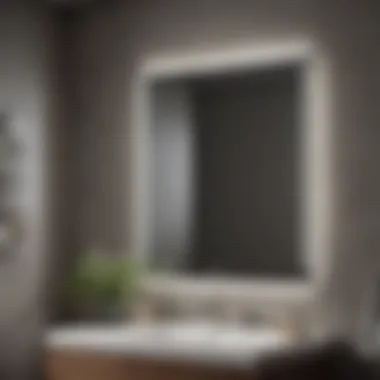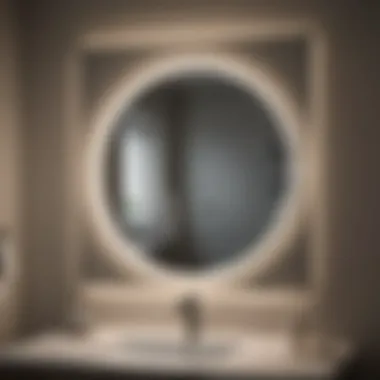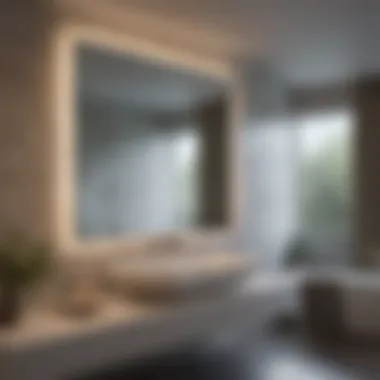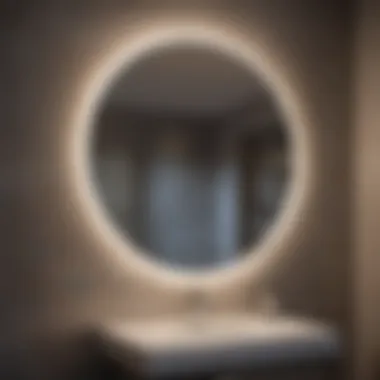Exploring Bathroom Mirrors with LED Lighting


Intro
The choice of a bathroom mirror can define the overall feel of a space. Mirrors serve a functional purpose in daily grooming tasks, but when you add LED lights, they transform into a crucial part of the bathroom's design. This article explores bathroom mirrors with LED lights, discussing the functional benefits and the aesthetic appeal they maintain.
Lighting affects not only visibility but also the mood of the room. LED-lit mirrors enhance the brightness of the area, making it feel larger, cleaner, and more inviting. It's essential to consider how these elements interplay in the bathroom, a space that often faces challenges regarding light quality. This article reviews key aspects, such as design inspirations, energy efficiency, installation, and maintenance, providing a well-rounded view for homeowners who seek to elevate their interiors.
Design Inspirations
As we delve into the world of LED bathroom mirrors, understanding the design inspirations behind them is vital. Many homeowners seek mirrors that not only serve a functional role but also blend seamlessly into their chosen aesthetic.
Trending Styles
In modern design, simplicity reigns supreme. Popular styles for LED mirrors include:
- Minimalist: Clean lines and sleek frames are favored. An unframed mirror with integrated LED lighting can offer a contemporary feel.
- Framed Exceptionalism: While minimalism shines, framed mirrors are also trendy. Wooden frames, metallic finishes, or ornate designs can provide character.
- Smart Technology: More mirrors now come with smart features—defogging capabilities, Bluetooth speakers, and adjustable brightness cater to those who look for convenience alongside style.
Color Palettes
The color of the lighting and the mirror itself can significantly influence the appearance of your bathroom. Common palettes include:
- Neutral tones: Whites, blacks, and grays remain timeless. They suit almost every bathroom design and can create a peaceful ambiance.
- Bold Choices: Some homeowners opt for warmer or cooler hues to make a statement. LED lighting allows for color temperature adjustments, further expanding design options.
In summary, choosing a bathroom mirror with LED lighting involves considerations beyond mere functionality. The balance between aesthetic appeal and practical application is crucial, serving dual roles in interior design.
"Good lighting is not just about visibility; it profoundly affects the user’s experience in the space."
Product Recommendations
When selecting LED-lit mirrors, certain products stand out for their design and functionality. Quality and performance are essential.
Bath Accessories
To enhance the performance of your LED mirror, consider complementary bath accessories that are both functional and stylish. Recommended products include:
- LED Light Strip: Additional light sources can enhance the mirror's brightness further.
- Storage Solutions: Organizers that help keep toiletries tidy contribute to an overall neat appearance.
Installation Tips
The installation of LED mirrors can vary based on their design and the layout of your bathroom. Here are some key considerations:
- Electrical Work: It is often beneficial to consult with an electrician. Proper wiring is essential for the safe setup of illuminated mirrors.
- Placement: Think about where the mirror will be hung. Center it above the sink for balanced lighting during grooming tasks.
In closing, bathroom mirrors with LED lights not only serve a functional purpose but also elevate the space's design. Homeowners should carefully consider each aspect, from stylistic choices to practical installation, to ensure a satisfactory result.
Intro to LED Bathroom Mirrors
In recent years, LED bathroom mirrors have surged in popularity, becoming a staple in modern home design. These mirrors integrate lighting technology to enhance both functionality and aesthetics within the bathroom space. The consistent, intuitive lighting provided transforms everyday tasks such as shaving, applying makeup, or getting ready into simpler and more effective routines. Moreover, the design aspect cannot be overlooked; LED mirrors often bring a stylistic edge that can complement various bathroom decors.
Choosing an LED bathroom mirror is not merely a cosmetic decision. The interplay of light can greatly change how space is perceived. This section explores the broad implications of incorporating LED mirrors, including their advantages, the evolution of lighting, and changing consumer preferences.
Defining LED Bathroom Mirrors
LED bathroom mirrors are essentially reflective surfaces integrated with light-emitting diodes (LEDs). They often feature lights encased around the mirror's perimeter or hidden behind its frame. This set-up provides an even glow that reduces shadows compared to traditional bathroom lighting.
In addition to basic functionality, many LED mirrors come with innovative features. For instance, some models include touch sensors for brightness adjustment or anti-fog functions, which enhance the user experience significantly. The marriage of form and function defines the essence of LED bathroom mirrors, appealing to those seeking efficiency alongside visual appeal.
The Evolution of Bathroom Lighting


Historically, bathroom lighting has evolved significantly. From basic overhead fixtures to wall sconces, illumination in these spaces has always focused on usability. Traditional incandescent bulbs served their purpose, but they lacked energy efficiency and longevity.
As technological advancements made LED lights commonplace, switching to this modern option has become essential. LEDs consume less energy and last much longer than their predecessors. They provide versatile lighting options, allowing homeowners to create unique atmospheres tailored to their needs. Recent developments have also brought smart technology into the mix, allowing for adjustable color temperatures and brightness levels to be controlled via smartphone apps.
Thus, the transition towards integrating LEDs in bathroom design not only meets practical requirements but also reflects broader trends in eco-conscious living.
The Importance of Lighting in Bathroom Design
Lighting plays a crucial role in the design and functionality of a bathroom. It influences not only how individuals use the space but also the overall atmosphere and aesthetic appeal. In a room where clarity and comfort are essential, having appropriate lighting can enhance daily routines, from grooming to relaxation. When considering bathroom design, it is important to recognize how various lighting elements come together to achieve both practical and visual benefits.
Functionality of Proper Lighting
Proper lighting is essential for performing everyday tasks in the bathroom. The two primary functions of bathroom lighting are visibility and safety. Adequate illumination allows individuals to see clearly while getting ready, ensuring that makeup application, shaving, and other tasks can be carried out effectively.
Improper lighting can lead to accidents. Dark corners and insufficient light can make it difficult to navigate the space, especially for children and older adults. Therefore, choosing the right type of lighting, such as LED lights, can provide a well-lit environment. LED lights emit a bright, white light that mimics daylight, enhancing visibility and reducing strain on the eyes.
Additionally, the ability to adjust brightness is also valuable. Dimmer switches can allow for versatile lighting options. For instance, bright light can be beneficial during the day, while softer lighting creates a calming environment for evening relaxation.
Creating Atmosphere and Ambiance
Beyond functionality, lighting has a significant impact on the mood of a bathroom. The ambiance created by carefully chosen lighting can transform the space. For many homeowners, a bathroom is not just a place for hygiene; it can function as a personal sanctuary. ☁
To create a tranquil atmosphere, consider layered lighting. This involves combining ambient, task, and accent lights in the design. Ambient lighting provides overall illumination, while task lighting focuses on specific areas like mirrors. Accent lighting highlights architectural features or decor, contributing to a cohesive look.
Different color temperatures also influence the atmosphere. Warmer lights can create an inviting, cozy space, while cooler tones may lend a more clinical or modern feel. Homeowners should select lighting that aligns with their personal style.
"The right lighting can turn an ordinary bathroom into a welcoming retreat, enhancing both aesthetics and functionality."
Overall, the importance of lighting in bathroom design is multifaceted. It extends beyond simple illumination; it encompasses considerations for functionality, safety, and creating a pleasing atmosphere.
Advantages of LED Lighting
LED lighting has grown popular in recent years, especially in bathroom mirrors. Understanding the advantages of LED lighting will help homeowners make informed decisions when choosing bathroom fixtures. The benefits are varied, ranging from energy efficiency to aesthetic options. Each benefit compounds the overall value that LED-lit mirrors can contribute to a space.
Energy Efficiency Compared to Traditional Bulbs
One of the leading benefits of LED lighting is its outstanding energy efficiency. LED lights consume significantly less electricity than traditional incandescent bulbs. Often, they use at least 75% less energy for the same level of brightness. This efficiency translates into lower electricity bills for households over time. Furthermore, many energy-efficient bath mirrors qualify for rebates, making them even more appealing.
Longevity and Durability of LED Lights
LED lights tend to outlast conventional bulbs, lasting up to 25 times longer. This durability means fewer replacements and less hassle for homeowners. When a bathroom mirror incorporates LED technology, the need for frequent bulb replacements is greatly reduced. Additionally, LEDs are less suscepible to broken filaments or shattered glass, which can be a concern with traditional bulbs. Their robust design makes them ideal for the often humid conditions of bathrooms.
Brightness and Color Temperature Options
Another advantage is the flexibility in brightness and color temperature that LED lighting provides. Homeowners can select options that best suit their preferences and needs. LED lights are available in various color temperatures ranging from warm yellow to cool blue tones. This flexibility allows users to create the desired mood or atmosphere in the bathroom. Switching between brighter settings for everyday use to softer tones for relaxation is simple and effective.
"LED lights can enhance both functionality and aesthetics, providing options that traditional bulbs do not."
Overall, the benefits of LED lighting make it a superior choice for bathroom mirrors. The combination of energy efficiency, longevity, and customizable brightness illustrates how LED-lit mirrors can transform a space into one of both practicality and beauty.
Design Options for LED Bathroom Mirrors
Design options for LED bathroom mirrors play a critical role in enhancing both the aesthetic and functional elements of a bathroom. The integration of LED lighting not only illuminates the space but also serves as a design statement. Homeowners today are increasingly focusing on how mirrors can enhance their overall décor while providing necessary illumination for daily grooming tasks.
The right mirror can complement cabinetry, tiles, and fixtures, creating a cohesive look. There are several crucial factors to consider when exploring design options, including the type of frame, style, and positioning of the mirror itself. These choices can influence not just the functionality but also the mood of the environment.
Highlighting LED mirrors in various designs allows homeowners to express their unique style while addressing practical needs.
Framed versus Frameless Designs


Framed mirrors provide a bit of traditional appeal, offering various styles from ornate wood to sleek metal finishes. They can act as a statement piece within the bathroom. A well-chosen frame can enhance existing décor or set a tone for the space. In contrast, frameless designs create a minimalist feel, making the bathroom appear larger and more open.
In addition to aesthetic elements, framed mirrors might require more careful cleaning to avoid dust accumulation in crevices. Frameless mirrors tend to be easier to maintain in this regard.
Wall-mounted versus Freestanding Models
The decision to choose wall-mounted or freestanding models depends largely on available space and personal preference. Wall-mounted mirrors have the advantage of saving floor space, making them ideal for smaller bathrooms. They are often more permanent fixtures, meaning that they are securely attached and do not require additional supports.
Freestanding models, on the other hand, offer versatility. They can be moved around to suit the layout of the bathroom. This is particularly useful in larger bathrooms where changing the configuration might be desired. They may also include additional storage space for towels or toiletries.
Customization and Style Variations
Customization is a significant aspect of modern LED bathroom mirrors. Homeowners can choose from various finishes, sizes, and lighting options tailored to their specific needs. The ability to select features like dimmable lights or integrated Bluetooth speakers adds functionality that enhances user experience.
Style variations also make LED mirrors suitable for various design themes—from contemporary to rustic. The choice of simple geometric shapes or intricate designs allows for personalized touches. Such options empower homeowners to create a bathroom space that truly reflects their taste and lifestyle.
Overall, the design options for LED bathroom mirrors are vast and significant. Balancing aesthetic preferences with practical considerations will lead to a well-designed bathroom that meets the needs of daily life.
Installation Considerations
When integrating LED-lit bathroom mirrors into your space, the installation process is a crucial aspect that requires careful thought and planning. The effectiveness of your LED mirror depends not only on its design and functionality but also on how well it is installed. Proper installation enhances usability, safety, and overall aesthetic appeal, making it essential to understand the various elements involved.
Electrical Requirements and Safety
One of the most significant aspects of installing LED bathroom mirrors involves understanding electrical requirements. Each mirror may have different specifications in terms of voltage and wattage. It is important to follow the manufacturer's guidelines and ensure the electrical system in your bathroom can handle the added load of the LED mirror.
Furthermore, safety is paramount.
- Ensure that all electrical installations are performed by qualified electricians to avoid accidental electrocution.
- Use GFCI (Ground Fault Circuit Interrupter) outlets in wet areas to provide extra protection against electrical faults.
- Inspect for any signs of water leakage that might jeopardize electrical components.
By prioritizing these safety measures, you can minimize risks and ensure a safe environment for all users.
Professional Installation versus DIY
When considering installation, homeowners often face the decision between hiring a professional or attempting a DIY project. Each option has its pros and cons.
Professional installation typically assures quality control. Professionals bring expertise and experience that can prevent common pitfalls such as improper wiring or placement issues. Moreover, they can provide a warranty on their work, which may give homeowners peace of mind.
On the other hand, DIY installation can be cost-saving and rewarding for those skilled in handling tools and have some level of electrical knowledge. It allows for flexibility in timing and personal touch in the installation process. However, it may lead to complications if mistakes occur during the installation.
For individuals who are not confident in their abilities or lack experience, it's usually best to opt for professional help. Ultimately, the choice between professional installation and DIY should be made based on the homeowner’s skills, budget, and specific installation needs.
Maintenance of LED Bathroom Mirrors
Maintaining LED bathroom mirrors is essential for both their functionality and aesthetic appeal. These mirrors represent a significant investment in home decor, combining modern technology with everyday utility. Regular maintenance can prolong the life of the mirror and ensure optimal performance. Taking time to understand the proper care techniques is important for homeowners seeking to enhance their bathrooms while avoiding unnecessary repairs or replacements.
Regular Cleaning Techniques
Cleaning LED bathroom mirrors requires attention to detail to maintain their clarity and functionality. Here are a few straightforward methods that can be efficiently employed:
- Use of Microfiber Cloths: A microfiber cloth is ideal for cleaning. It prevents scratches and effectively removes dust and moisture without leaving streaks.
- Gentle Cleaners: Always opt for non-abrasive, mild cleaners. Harsh chemicals can cause damage to the mirror surface and LED components. A mixture of water and a small amount of dish soap can work well.
- Avoiding Excess Water: When cleaning, it is crucial to avoid saturating the mirror. Excess water can leak into the wiring, potentially causing electrical issues. Use a damp cloth rather than soaking it.
- Regular Dusting: Establish a routine to dust the mirrors regularly to prevent buildup. Dust can accumulate quickly in a bathroom environment and affect the light quality.
- Cleaning the LED Frame: If the mirror has a frame, ensure that it is cleaned as well. The frame can collect dust and moisture that will detract from the overall appearance of the mirror.
Implementing these techniques can help keep the mirror looking new while ensuring the LED light functions efficiently.
Identifying and Addressing Potential Issues
With the benefits of LED bathroom mirrors come the responsibilities of ensuring they remain in peak condition. Identifying issues early can save time and repair costs. Here are common problems and solutions to be aware of:
- Flickering Lights: If the LED lights flicker, it could indicate a power issue. Ensure the connections are secure or consult a professional for hardware inspection.
- Moisture Build-up: Bathrooms often experience high humidity, which can cause moisture to affect the LED circuitry. If you notice condensation, consider adding a bathroom fan or improving ventilation.
- Light Dimness: Should the light appear less bright than normal, check the power supply. Sometimes, bulbs may not function at full capacity due to poor connections.
- Visible Damage or Cracks: Inspect the mirror for any physical damage. Cracks can worsen and lead to further issues. Addressing these damages promptly can prevent further degradation.


Regular maintenance is crucial. Identifying issues early not only protects your investment but also ensures a consistently functional and visually appealing fixture.
By following these maintenance tips and addressing potential problems swiftly, homeowners can enjoy the benefits of LED bathroom mirrors for years. This not only enhances the bathroom's overall functionality but also contributes positively to its aesthetic value.
Potential Drawbacks of LED Bathroom Mirrors
While LED bathroom mirrors offer numerous advantages, it is also necessary to consider potential drawbacks. Understanding these aspects can help homeowners make informed decisions. This section delves into key considerations, focusing on initial costs and light color sensitivity.
Initial Cost Considerations
One of the notable drawbacks of LED bathroom mirrors is their initial cost. While traditional mirrors can be inexpensive, LED mirrors often come with a higher price tag. Factors contributing to this cost include the technology behind LED lighting and often the features that these mirrors incorporate. Homeowners should evaluate their budgets and determine if the benefits justify the expense.
Despite the initial investment, many find that the savings on energy costs over time can offset the difference. Furthermore, some LED mirrors are designed to last significantly longer than their traditional counterparts, reducing the frequency of replacements. Yet, the upfront costs remain a primary concern for many home decorators.
Light Color Sensitivity
Another factor is light color sensitivity. Different LED mirrors emit various color temperatures, which can affect the experience and usability. Some individuals may find certain LED lights too harsh or overly cool, while others prefer warmer tones. This sensitivity to light color can influence how well individuals can perform tasks in front of the mirror, such as applying makeup or shaving.
Finding the right LED mirror involves understanding the color temperature range, usually measured in Kelvin (K). Standard temperatures can range from warm white at around 2700K to cool white at 5000K or more. Choosing a temperature that suits personal preference is essential.
"Selecting the right LED bathroom mirror can enhance not only the functionality of your space, but also your overall daily routine."
Trends and Innovations in LED Bathroom Mirrors
In recent years, LED bathroom mirrors have undergone significant transformations. These changes not only enhance functionality but also elevate the aesthetics of modern bathrooms. Understanding the latest trends and innovations is essential for anyone considering an upgrade or renovation. Today’s consumers prioritize features that combine technology with practicality, leading to an increased demand for smart mirrors and eco-friendly designs.
Smart Features and Technology Integration
Smart technology has found its place in household items, and bathroom mirrors are no exception. Many LED bathroom mirrors now come equipped with features such as touch sensors, Bluetooth connectivity, and even integrated speakers. These features allow users to control lighting easily or listen to music while preparing for their day.
Benefits of Smart Features:
- Convenience: The ability to adjust brightness or temperature with a simple touch promotes ease of use.
- Multifunctionality: Mirrors can serve as media hubs, providing a space for entertainment and information.
- Customization: Some mirrors allow users to save preferred settings for future use.
Moreover, advanced options include fog-free technology and anti-glare surfaces. These innovations ensure clarity for tasks like shaving or applying makeup. As in the smart home trend, these mirrors often integrate with home automation systems, allowing users to control multiple aspects of their environment from one central place.
Sustainable Options and Eco-friendly Designs
Environmental awareness influences modern design choices. Consumers are increasingly looking for features that align with a more sustainable lifestyle. LED bathroom mirrors often lead the way in this area due to their energy-efficient nature.
Eco-friendly Considerations:
- Energy-saving: LED lights consume significantly less power than traditional bulbs, reducing energy costs and minimizing the carbon footprint.
- Longevity: LED lights outlast incandescent bulbs, which results in less frequent replacements and decreased waste.
- Materials: Many manufacturers use recyclable materials in their products to further enhance sustainability.
Design trends also reflect the growing preference for minimalist and natural aesthetics. Mirrors framed with reclaimed wood or made from sustainable materials offer a distinctive touch while promoting eco-friendly practices. These choices not only create an inviting atmosphere but also appeal to a sense of responsibility towards our resources.
"Sustainability is not just about energy; it encompasses the materials and processes used to create products we love."
End
The inclusion of LED bathroom mirrors represents an important development in both function and style for any modern home. In this article, we examined the various facets of LED-lit mirrors, highlighting their importance in enhancing not just lighting, but overall bathroom experience.
LED bathroom mirrors provide a blend of utility and design appeal. They help in activities such as grooming, applying makeup, or simple daily routines. Proper lighting is crucial in achieving the right look, and LED mirrors offer brightness and clarity that surpass traditional illumination methods.
Besides functionality, the aesthetic element of LED mirrors cannot be overlooked. They come in various designs that can fit seamlessly into different bathroom styles, be it contemporary, classic, or minimalist. As homeowners become aware of energy efficiency, the long lifespan and low power consumption of LED lights present a compelling reason to adopt these fixtures.
Furthermore, considerations regarding installation and maintenance are less demanding than one might initially think. With proper guidelines, the installation can be straightforward for many individuals, whether opting for a professional or DIY approach. Regular maintenance involves simple cleaning techniques that keep these mirrors looking new.
However, there are potential drawbacks worth noting, such as the initial cost and light color sensitivity. Understanding these aspects allows homeowners to make informed decisions relating to installation and purchase. Being educated about the latest trends, including smart technology integration, adds to the value proposition of LED mirrors.
Thus, LED bathroom mirrors emerge as a notable choice for both their practical and aesthetic contributions to home design. They encapsulate a forward-thinking approach towards enhancing personal spaces, ensuring that functionality does not compromise style.
"Choosing LED bathroom mirrors is a step towards a modern and efficient home, balancing functionality with a sharp aesthetic appeal."
Whether one is renovating a current space or starting from scratch, these mirrors offer practical solutions with significant benefits.



